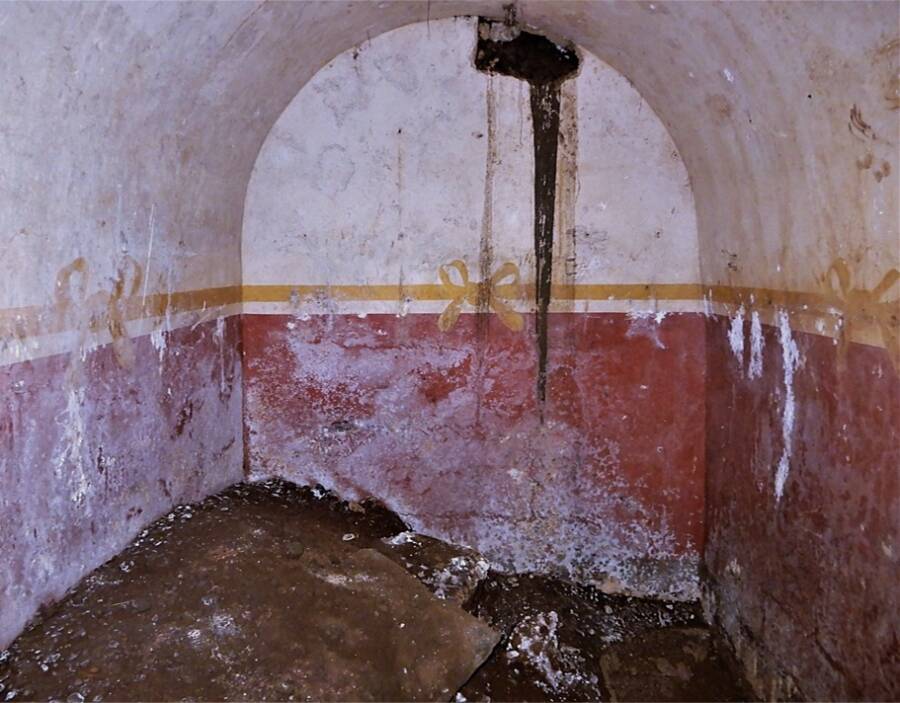The city of Aegae (present-day Vergina) was the original Macedonian capital and was long a burial place for royalty.

Angeliki KottaridiThe tomb is about 2,300 years old and belonged to ancient nobility.
History is everywhere in the ancient Macedonian city of Aegae (present-day Vergina). And the construction of a new sewage system in the area has just revealed a stunning ancient tomb.
Researchers believe that the tomb belonged to a local nobleman and his wife, who were buried back in the 3rd century B.C.E.
The Discovery Of The Tomb
The discovery of the tomb was announced at the 36th Annual Archaeological Meeting of “the Archaeological Project in Macedonia and Thrace in 2023” by Angeliki Kottaridis, the Honorary Superintendent of Antiquities.
As Kottaridis explained in her presentation, the tomb was discovered during the construction of a new sewage network in Aegae, which is located in Imathia, Central Macedonia.

Ephorate of Antiquities of ImathiaAn aerial view of the ancient palace and the theater of Aegae.
“Of course it didn’t damage him, the excavation stopped immediately and we dug him up,” she explained according to local media. “An operation was immediately carried out to preserve the facade, because it had mortars and then we opened it, not much, just enough to be able to enter.”
They discovered a tomb with a simple facade and a doorway enclosed with a pile of stones. Upon entering, the archaeologists discovered a space measuring roughly 12 feet by nine feet, decorated with painted golden bands designed to resemble ribbons with bows.
According to Kottaridis, the tomb appears to be an “important grave” because the man interred there was buried with a shield “reinforced with iron parts” as well as a number of well-preserved weapons that show the mark of superior craftsmanship.
The man was not buried alone. The facade of the tomb appears to have been completed in two phases, once for him and once for a woman, likely his wife, who was found inside. She was laid to rest with a number of grave goods, including beads, necklaces, and a golden myrtle wreath.
Researchers believe the tomb dates back to the 3rd century B.C.E. And it was not the only incredible discovery that Kottaridis presented.
The Rich Archaeological History Of Aegae
As Kottaridis noted, excavations closer to the “heart” of the necropolis of Aegae also uncovered the burial of a warrior who was laid to rest with a number of remarkable objects, including his helmet laid at his feet.
“[H]e has a nice sword that he also holds in his right hand, his rings have fallen off and we also have the fibula that held the chlamys [a cloak worn by men in ancient Greece],” Kottaridis explained, according to local media.

Angeliki KottaridiThis warrior’s helmet was one of the many remarkable discoveries made recently in Aegae.
These exciting finds were discovered near another tomb documented in 1969 alongside two more mounds. Archaeologists suspect that they are part of a collection of rich tombs.
That’s no surprise. Aegae has long been a city of royal burials.
Aegae, the original capital of Macedonia, played an important role in ancient history. It was there, in 336 B.C.E., that Philip II of Macedon was murdered, paving the way for his son Alexander the Great to become king.
Indeed, many of Alexander the Great’s relatives are buried there. An elaborate site called the Great Tumulus in Aegae contains the remains of the conquerer’s father, his half-brother, and his son.
As such, the newly discovered nobleman’s tomb belongs to a long and rich history in Aegae — one that archaeologists are still uncovering today.
After reading about the tombs discovered in Macedonia during the construction of a sewage system, go inside the ongoing quest to discover Alexander the Great’s tomb. Or see why Alexander the Great’s death is still something of a historical mystery.





